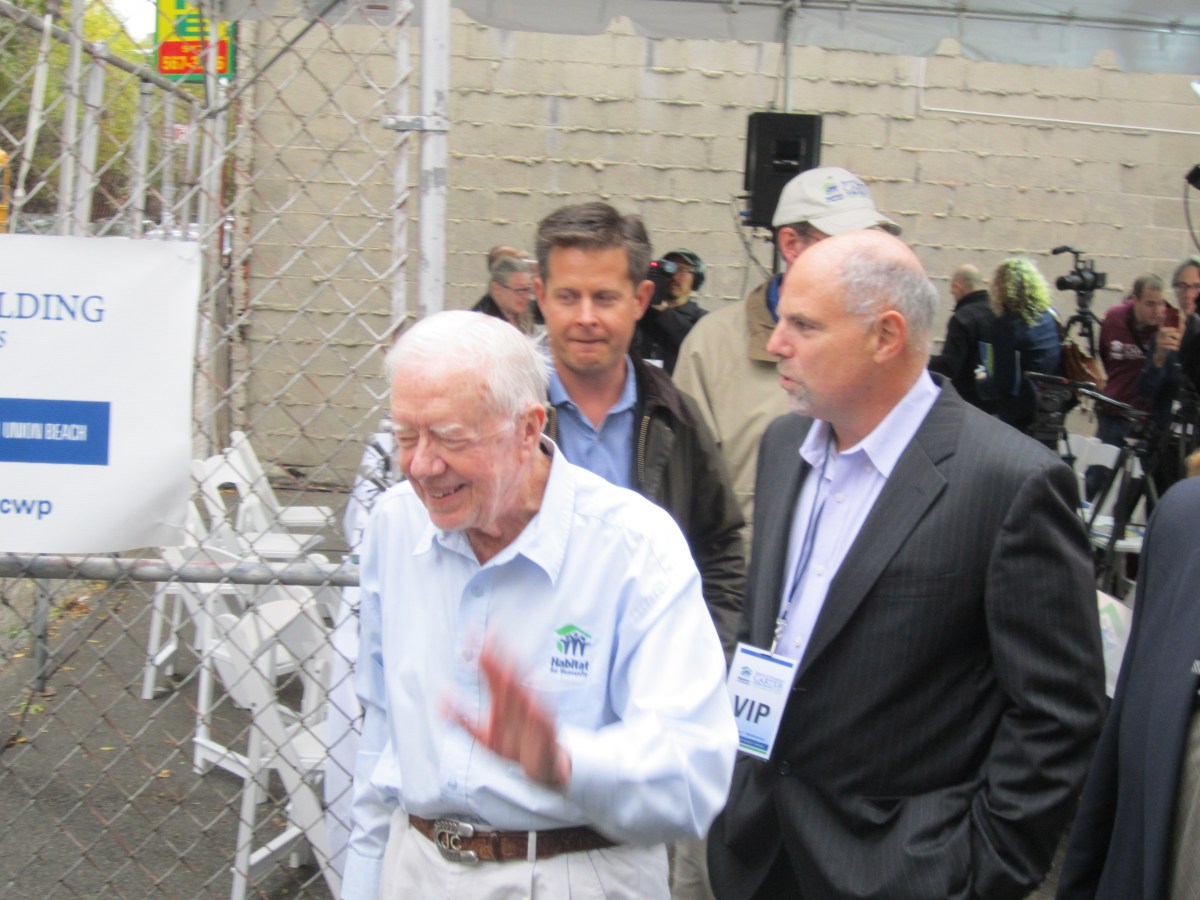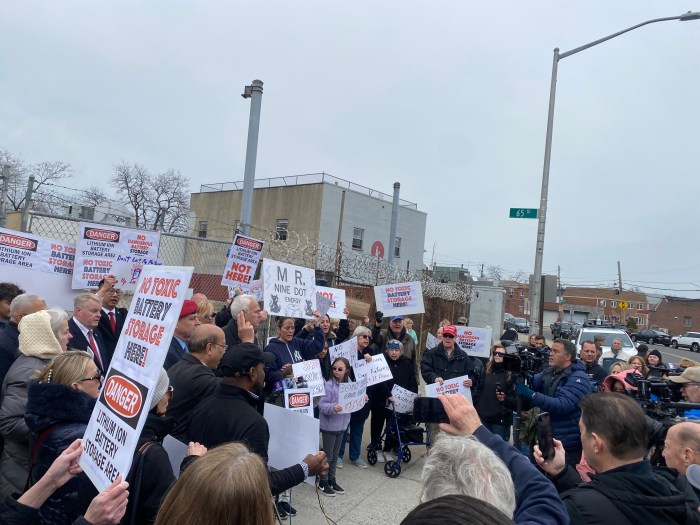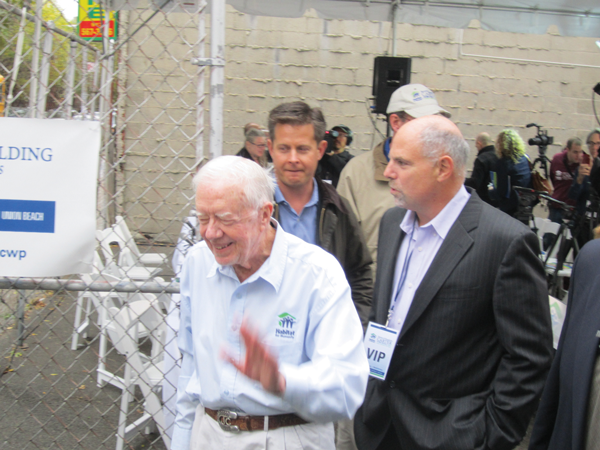
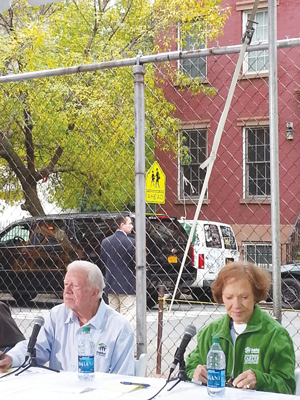
BY HEATHER DUBIN | Former President Jimmy Carter and his wife, Rosalynn, brought their Southern charm to the East Village last Thursday to commemorate 30 years of Habitat for Humanity service.
Housing has been a priority for Jimmy Carter, who has dedicated his post-presidential career to ensuring this basic right for thousands of families in need.
The couple celebrated the 30th Annual Jimmy & Rosalynn Carter Work Project last week with a return visit to a building called Mascot Flats, at 742 E. Sixth St., between Avenues C and D, which was the project’s first site. Before holding a press conference, the Carters met with 12 of the original tenants who still live in the 19-unit building, in the apartment of Don Kao.
In 1984, the Carters embarked on a renovation of the six-story building with local homesteaders and Habitat for Humanity. Built in 1902, the East Village tenement no longer had a roof, and fit in well amid the blown-out, abandoned buildings in the neighborhood in the ’80s when it was infested with drugs and crime.
The Carters were reflective as the two reminisced about the experience, and the powerful affects of helping people build their own homes. Jimmy Carter, 89, recalled jogging over to look at the site and finding it a “horrible mess.” While he has worked as a Habitat volunteer for 30 years, and been to about 85 different building sites, he dubbed Mascot Flats his most memorable.
“You could stand on the second floor, if you could get up there, and you could look up and see the sky,” he recalled. “The garbage was more than knee deep. And there were fires where people were living, and cooking up food and dope.”
Carter also mentioned that the buildings’ 370 windows were all broken and without frames.
“That’s what we had to start with, and it took us two years to finish it,” he said.
In a follow-up phone interview, Ann Rupel, 60, an original homesteader and president of the co-op board at Mascot Flats, claimed each tenant was required to devote 1,000 hours of manual labor — half on the building’s construction, and the rest on another project.
“We managed to put 1,000 hours on that building,” she said. “So did a lot of people.”
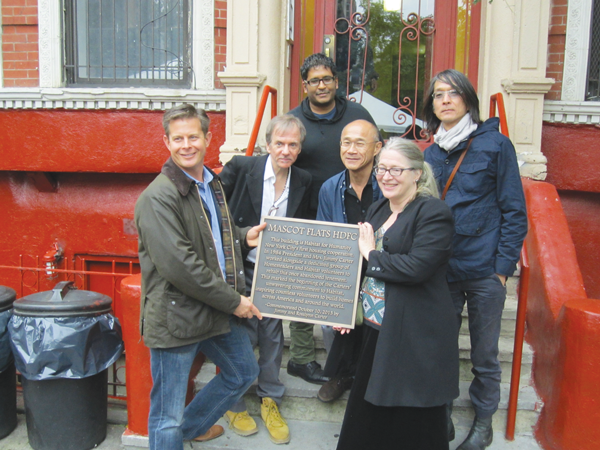
Rosalynn Carter, 86, was introduced by her husband as, “the boss of my work camp…who has been bossing me around now for 67 years.” She noted she was initially reluctant to swing a hammer at the site.
“Before we got here, I told Jimmy that I was not going to do any hammering,” she recalled. “The only thing I’d ever done was put a nail in the wall to hang a picture up.”
The former first lady spent her first day at Mascot Flats pulling linoleum up off the floor with some other women. Later that day, a man brought them some flooring with instructions from the former president to nail it in. Her earlier protest was for naught, and with a laugh, she exclaimed, “After 30 years, I’ve become a very accomplished carpenter.”
The Carters also spoke of how building homes across the world — Habitat for Humanity is in 75 countries — is a stabilizing force for families.
“We’ve seen their lives transform,” Jimmy Carter said. Under the program, a house — which is built and purchased by the families — becomes a point of pride, and a vehicle for change. Improvements in education, healthcare and safety are much more obtainable in a better home environment, they said.
“It’s almost always emotional when you meet someone who’s never had a home, or who’s never ever dreamed of having a home,” Rosalynn said. “Then you give them a home, and we always cry when we give them the keys.”
She referenced an original tenant named Jessica who was a dishwasher when they first met her at Mascot Flats.
“Next time we came back, she was an apprentice in the carpenters union, she had learned a trade,” Rosalynn said.
Habitat for Humanity also fosters new work experiences. For example, in a project in Nicaragua, participants made bricks and tiles for the houses, and then profited from doing the same thing for other villages.
The Carters’ international work has included the Philippines with 14,000 volunteers at their largest site yet. They built 293 homes in only five days. Also, the Carters have been in Haiti, where they constructed 300 homes in what had been the epicenter of the 2010 earthquake.
“The homes are now beautiful,” the former president said. “It’s an oasis in the middle of a still-devastated country.”
“It’s been a labor of love for us, as you can tell. We’re very proud to be here,” he added.
Kao, director of Project Reach, a youth program, and Rupel, a medical research writer and a musician, both addressed the crowd and expressed their gratitude to the Carters. Each raised a child in the building.
Kao, 62, disclosed he has been living with AIDS for almost 30 years. The building has been instrumental in his life. When he was sick, he needed someone to carry him three flights up to his apartment.
“All of that couldn’t have happened, and I couldn’t have been here today, in part, without that building behind me,” he said. “It allowed me to care of myself, take care of my health and run an organization.”
Meanwhile, Kao added that “prices have skyrocketed” in the neighborhood, and that the property next door “sold for almost $2 million and set the price for all around.” He said he had the Carters to thank for his being able to remain in the neighborhood.
This naturally led to the topic of gentrification when it came time for reporter questions. When asked about it, Jimmy Carter said, “It cuts both ways.” However, he did say gentrification was good. He noted that the second year Habitat for Humanity was at Mascot Flats, people in the neighborhood cleaned up empty lots and planted community gardens there.
“Once you build some decent homes that people actually own, it gentrifies every neighborhood,” he said.
He noted he has not returned to a former work site where upkeep is an issue.
“People are so proud of their own homes that they bought, and worked on for hundreds of hours, and paid for full price to let anybody do any damage to it,” he said.
The apartments at Mascot Flats were not given away. As Jimmy Carter stated, Habitat for Humanity only gives away “love and compassion.” He thought the people who first moved in paid $30,000 for an apartment, which they could have turned around and sold for almost six times the price.
“We put a restraint on the homes here as they sold, so Habitat would have partial ownership, and could use that money to build more homes,” he said.
However, another original tenant, “Doc” Aroyo, recalled that the purchase price for his apartment was $50,000, though the mortgage was interest-free.
When asked about the national mortgage crisis, the former president advocated for regulations to control banks.
“We do need a very strict law to be passed to prevent that profiting off of innocent borrowers who are given a loan that the bank knows they can’t repay, just so the bank can make a profit by reselling the mortgages,” he said. According to him, these protections were partially in place through a law passed a few years ago, but Congress is blocking the law from implementation by withholding funds.
“The average person making a loan to buy a house doesn’t have any lobbyist in Washington to protect his or her interests,” he said. “But the rich folks that are benefiting from this, they have lobbyists to protect their interests, and I think this changed dramatically in the last 30 years,” he said. Carter said he also feels there has been a lowering of expectations in the States, and a “stalemate” in social mobility.
As for Congress, and its current standstill, he had a few words of advice and a recommendation that its members all go work for a day on a Habitat site, where cooperation is key.
“We respect authority, and when we have a building superintendent or house leader, everybody that works on the Habitat site pays attention to instructions for the well-being of everybody,” he stated. “And secondly, there’s no distinction whether you’re Christian, Muslim or Jew, Democrat or Republican, man or a woman — you’re all working for the same goal.”
The Carter Project was also in Oakland, San Jose and Denver last week. The rest of the sites include Queens, Staten Island and Union Beach, N.J. There were 1,000 volunteers in New York to renovate and repair 15 homes damaged by Hurricane Sandy last year.



